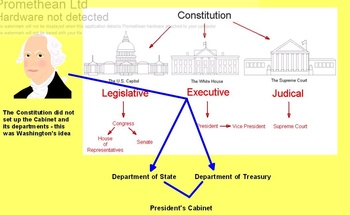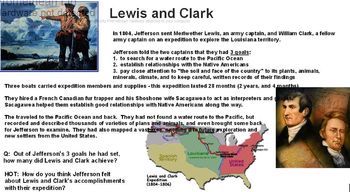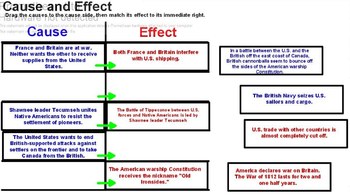Life in a New Nation: The Young United States
EducPrek12
230 Followers
Grade Levels
5th - 7th
Subjects
Resource Type
Formats Included
- Flipchart File
Pages
49 pages
EducPrek12
230 Followers
Description
This flipchart is aligned with Scott Foresman Social Studies 5th Grade: The United States textbook and workbook Ch. 11: The Young United States. It is about 3-4 weeks worth of lessons/content for your history class. It contains Lesson 1: Washington as President, Lesson 2: Jefferson Looks West, and Lesson 3: Another War with Britain. It teaches historical figures consisting of George Washington, John Adams, Abigail Adams, Thomas Jefferson, Alexander Hamilton, Washington's Cabinet, Pierre L'Efant, Benjamin Banneker, Daniel Boone, James Monroe, Napoleon, Meriwether Lewis, William Clark (Lewis and Clark), Sacagawea, Henry Clay, Oliver Hazard Perry, Francis Scott Key, Tecumseh, James Madison, Dolley Madison, and Andrew Jackson.
Week 1, 18 slides (about 5 days worth of content):
Washington as President
It opens with a title page, then a list of objectives to be covered throughout the unit. Next, it gives the title page of the first lesson, with a picture of George Washington, facts about him, dates of his presidential term, along with a higher order thinking prompt. Next, is a list of vocabulary terms: electoral college, inauguration, Cabinet, and political party, along with their definitions. The next slide gives information about George Washington's presidency. The next slide gives a break down (with a visual chart, of the branches of government, including the system that George Washington (separate from the Constitution set up). The next page shows Washington's Cabinet and their purpose. The next page shows the political parties that were born and the differences between the two. The next page discusses the beginning of the Nation's Capital. The next page is teaches about John Adams and his presidency. The following page is a timeline that gives a summary of events from Lesson 1 on a timeline. The lesson then moves toward a vocabulary matching page, in which the students can match the term to its definition. The next activity is "Name That Historical Figure!" which will quiz students on everything they've learned from Lesson 1. It will give 2-4 hints describing the historical figure and you can have students write it on their markerboard individually (or a piece of paper if they don't have markerboards), work in groups or teams, or whole group. I did mine with "Show Down!" having them write it on their board and when I call "Show Down!" they would hold it up to see if they were correct. This activity allows students to name 6 historical figures that they learned about from Lesson 1.
Week 2, 20 slides (about 5 days)
Jefferson Looks West
Lesson 2: Jefferson Looks West opens with a title page of President Jefferson, facts and quotes from him, dates of his presidential term, and a higher order thinking prompt. The next page are vocabulary terms along with their definitions: pioneer, frontier, and Louisiana Purchase. The next page is dedicated to Thomas Jefferson and his presidency, along with another higher order thinking prompt. The lesson moves toward Daniel Boone and the early pioneers, discussing the Native Americans, westward movement, Wilderness Road, the Cumberland Gap, and lives of the early pioneers. The lesson then discusses the Louisiana Purchase, giving a map visual, events that led up to it, and the final purchase, along with another higher order thinking question for students. The next page goes onto discusses Lewis and Clark and their expedition, with pictures and questions. The lesson then discusses the nation's growth at this point in time. Next, it gives a timeline of all the events from lesson 2. Then, you have a vocabulary matching activity from the vocabulary words from lesson 2. The next 10 pages are a "Show-Down!" activity, in which students can write on their markerboards or paper, the answer to the questions asked about lesson 2. The next activity teaches Population Density Maps. Students can see and compare a population map from 1790 to a population map of 1820. This slide is accompanied with questions to check students' understanding of reading these types of distribution maps.
Week 3, 11 slides (about 5 days)
Another War with Britain
This lesson opens with a title page with information to the opening of the War of 1812. The next page is a list of vocabulary terms along with their definitions: neutral, Battle of Tippecanoe, War Hawks, War of 1812, national anthem, and Battle of New Orleans. The next page gives pictures and information on Tecumseh and the Battle of Tippecanoe. The lesson then discusses James Madison, his presidency, dates of office, and a background to the War of 1812. The next page gives a picture and information on the Battle of New Orleans, along with higher order thinking questions. The lesson then shows a timeline of events that occurred in lesson 3. Next, is a vocabulary matching page, in which students can draw a line from the term to its definition. The next is a color-coded Cause/Effect charting activity. All of the causes are in blue, and the effects in red. The students must drag the cause in the cause column, and then drag its effect next to it into the effect column, showing the Cause/Effect relationships of events that occurred during this time period.
The last page allows for review and closure of what students have covered over the last few weeks (although the teacher can incorporate this at the end of each daily lesson). Next, gives a list of 3 fun journal prompts, that align with project-based learning.
Great, informative lessons!
Week 1, 18 slides (about 5 days worth of content):
Washington as President
It opens with a title page, then a list of objectives to be covered throughout the unit. Next, it gives the title page of the first lesson, with a picture of George Washington, facts about him, dates of his presidential term, along with a higher order thinking prompt. Next, is a list of vocabulary terms: electoral college, inauguration, Cabinet, and political party, along with their definitions. The next slide gives information about George Washington's presidency. The next slide gives a break down (with a visual chart, of the branches of government, including the system that George Washington (separate from the Constitution set up). The next page shows Washington's Cabinet and their purpose. The next page shows the political parties that were born and the differences between the two. The next page discusses the beginning of the Nation's Capital. The next page is teaches about John Adams and his presidency. The following page is a timeline that gives a summary of events from Lesson 1 on a timeline. The lesson then moves toward a vocabulary matching page, in which the students can match the term to its definition. The next activity is "Name That Historical Figure!" which will quiz students on everything they've learned from Lesson 1. It will give 2-4 hints describing the historical figure and you can have students write it on their markerboard individually (or a piece of paper if they don't have markerboards), work in groups or teams, or whole group. I did mine with "Show Down!" having them write it on their board and when I call "Show Down!" they would hold it up to see if they were correct. This activity allows students to name 6 historical figures that they learned about from Lesson 1.
Week 2, 20 slides (about 5 days)
Jefferson Looks West
Lesson 2: Jefferson Looks West opens with a title page of President Jefferson, facts and quotes from him, dates of his presidential term, and a higher order thinking prompt. The next page are vocabulary terms along with their definitions: pioneer, frontier, and Louisiana Purchase. The next page is dedicated to Thomas Jefferson and his presidency, along with another higher order thinking prompt. The lesson moves toward Daniel Boone and the early pioneers, discussing the Native Americans, westward movement, Wilderness Road, the Cumberland Gap, and lives of the early pioneers. The lesson then discusses the Louisiana Purchase, giving a map visual, events that led up to it, and the final purchase, along with another higher order thinking question for students. The next page goes onto discusses Lewis and Clark and their expedition, with pictures and questions. The lesson then discusses the nation's growth at this point in time. Next, it gives a timeline of all the events from lesson 2. Then, you have a vocabulary matching activity from the vocabulary words from lesson 2. The next 10 pages are a "Show-Down!" activity, in which students can write on their markerboards or paper, the answer to the questions asked about lesson 2. The next activity teaches Population Density Maps. Students can see and compare a population map from 1790 to a population map of 1820. This slide is accompanied with questions to check students' understanding of reading these types of distribution maps.
Week 3, 11 slides (about 5 days)
Another War with Britain
This lesson opens with a title page with information to the opening of the War of 1812. The next page is a list of vocabulary terms along with their definitions: neutral, Battle of Tippecanoe, War Hawks, War of 1812, national anthem, and Battle of New Orleans. The next page gives pictures and information on Tecumseh and the Battle of Tippecanoe. The lesson then discusses James Madison, his presidency, dates of office, and a background to the War of 1812. The next page gives a picture and information on the Battle of New Orleans, along with higher order thinking questions. The lesson then shows a timeline of events that occurred in lesson 3. Next, is a vocabulary matching page, in which students can draw a line from the term to its definition. The next is a color-coded Cause/Effect charting activity. All of the causes are in blue, and the effects in red. The students must drag the cause in the cause column, and then drag its effect next to it into the effect column, showing the Cause/Effect relationships of events that occurred during this time period.
The last page allows for review and closure of what students have covered over the last few weeks (although the teacher can incorporate this at the end of each daily lesson). Next, gives a list of 3 fun journal prompts, that align with project-based learning.
Great, informative lessons!
Total Pages
49 pages
Answer Key
N/A
Teaching Duration
3 Weeks
Report this resource to TPT
Reported resources will be reviewed by our team. Report this resource to let us know if this resource violates TPT’s content guidelines.





